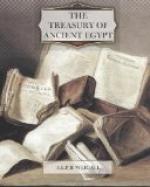The Egyptian loved his garden, and filled it with all manner of beautiful flowers. Great parks were laid out by the Pharaohs, and it is recorded of Thutmosis III. that he brought back from his Asiatic campaigns vast quantities of rare plants with which to beautify Thebes. Festivals were held at the season when the flowers were in full bloom, and the light-hearted Egyptian did not fail to make the flowers talk to him, in the imagination, of the delights of life. In one case a fig-tree is made to call to a passing maiden to come into its shade.
“Come,” it says, “and spend this festal day, and to-morrow, and the day after to-morrow, sitting in my shadow. Let thy lover sit at thy side, and let him drink.... Thy servants will come with the dinner-things—they will bring drink of every kind, with all manner of cakes, flowers of yesterday and of to-day, and all kinds of refreshing fruit.”
Than this one could hardly find a more convincing indication of the gaiety of the Egyptian temperament. In the eighteenth and nineteenth centuries A.D. the people were so oppressed that any display of luxury was discouraged, and a happy smile brought the tax-gatherer to the door to ascertain whether it was due to financial prosperity. But the carrying of flowers, and other indications of a kind of unworried contentment, are now again becoming apparent on all sides.
[Illustration: PL. IX. A garland of
leaves and flowers dating from about
B.C.
1000. It was placed upon the neck of a
mummy.
—CAIRO
MUSEUM.]
[Photo by E. Brugsch Pasha.
The affection displayed by the Egyptians for bright colours would alone indicate that their temperament was not melancholic. The houses of the rich were painted with colours which would be regarded as crude had they appeared in the Occident, but which are admissible in Egypt where the natural brilliancy of the sunshine and the scenery demands a more extreme colour-scheme in decoration. The pavilions in which the nobles “made a happy day,” as they phrased it, were painted with the most brilliant wall-decorations, and the delicately-shaped lotus columns supporting the roof were striped with half a dozen colours, and were hung with streamers of linen. The ceilings and pavements seem to have afforded the artists a happy field for a display of their originality and skill, and it is on these stretches of smooth-plastered surface that gems of Egyptian art are often found. A pavement from the palace of Akhnaton at Tell el Amarna shows a scene in which a cow is depicted frisking through the reeds, and birds are represented flying over the marshes. In the palace of Amenhotep III. at Gurneh there was a ceiling decoration representing a flight of doves, which, in its delicacy of execution and colouring, is not to be classed with the crude forms of Egyptian decoration, but indicates an equally light-hearted temperament in its creator. It is not probable that either bright colours or daintiness of design would emanate from the brains of a sombre-minded people.




